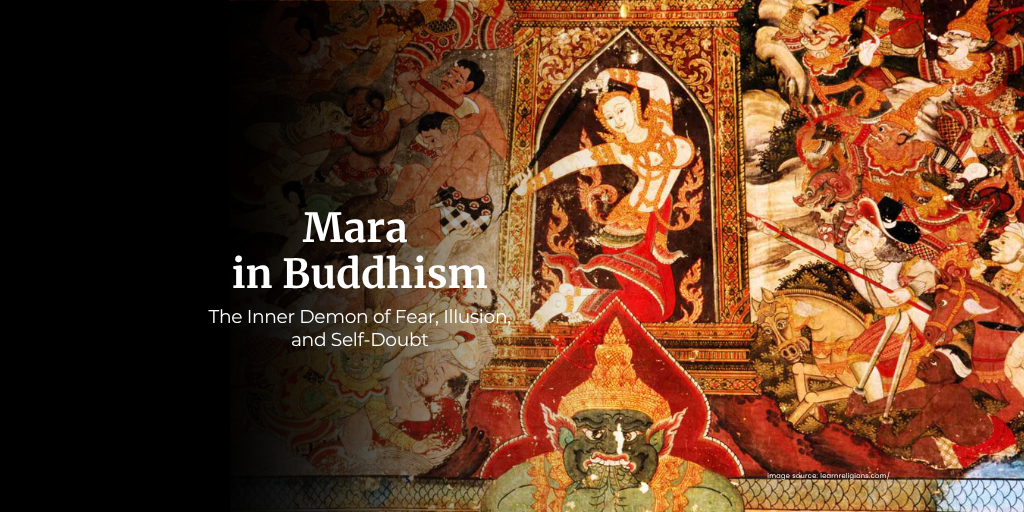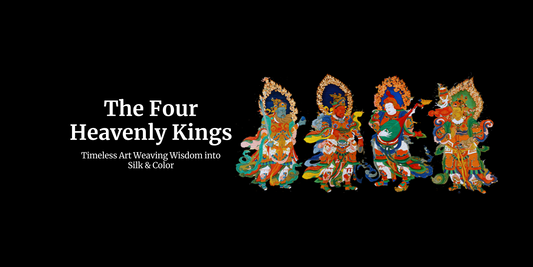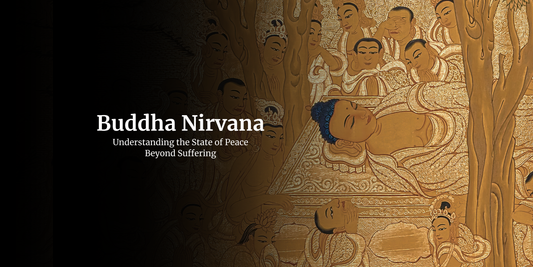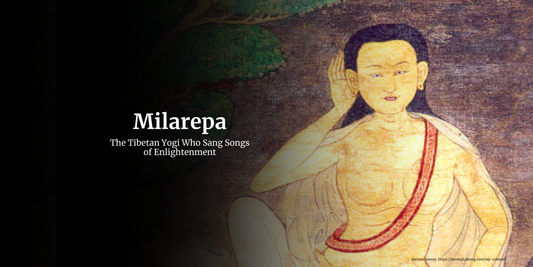- Buddhas Art of Healing
- Thangka Blog | Insights on Tibetan Thangka Art, Symbolism & Tradition
- Mara in Buddhism: The Inner Demon of Fear, Illusion, and Self-Doubt

Mara in Buddhism: The Inner Demon of Fear, Illusion, and Self-Doubt
Do you think that demons are just a myth? Think again. Mara in Buddhism isn’t some monster from the past. He’s the fear, doubt, ego, and temptation living in your mind right now.
He’s the voice that says, “You can’t," “You’re not enough,” or “Just give up.” And he almost stopped the Buddha himself.
But here’s the truth: You can’t awaken until you face your Mara.
Let’s uncover who Mara really is and how recognizing him might be the first step to freeing your mind.
Who is Mara in Buddhism?
The word “Mara” comes from the root of Sanskrit, which means “death.” In Buddhist philosophy, Mara is known as the “bringing of death.” Not only physical death, but he also brings death to virtue, knowledge, and awakening.
In the visual illustration, Mara looks like a demon, complete with weapons, a fierce expression, and an army of frightening followers. But in truth, Mara is not an external force. He symbolizes the internal enemies of the mind.
Mara and Siddhartha Gautama
The most famous story of Mara appears in the life of Siddhartha Gautama, the historical Buddha. On the eve of his enlightenment, Siddhartha was sitting under the tree of Bodhi until he discovered the truth, determined not to rise until he had discovered the truth.
- Sensing this, Mara appeared, determined to stop it.
- He sent his daughters to seduce Siddhartha and awaken desire.
- He unleashed a terrifying army of demons to spark fear.
- And finally, he challenged Siddhartha’s right to find enlightenment, appealing to the ego, and tried to shake his resolve.
But Siddhartha remained unmoved.
The Four Maras in Buddhist Philosophy
In deeper Buddhist teachings, Mara isn’t just one demon. He appears in four psychological and existential forms, known as the Four Maras:
-
Klesha Mara: The Mara of mental fallacies such as desire, anger, greed, jealousy, and ignorance. This is the voice that tells you that "you are not enough" or pushes you towards craving.
-
Skandha Mara: The Mara of clinging to the five aggregates (form, feeling, perception, mental formations, and consciousness), which give rise to the illusion of a fixed self.
-
Mrityu Mara: The Mara of death represents our fear, loss, and fear of mortality.
- Devaputra Mara: The Mara of pleasure and distraction—subtle comfort and worldly awards that draw us away from the spiritual path.
In Buddhism, Mara is not to be feared as a villain but to be studied and recognized. He represents the internal barriers that block awakening.
The Night of Enlightenment: Buddha vs Mara
The climactic confrontation between the Buddha and Mara is one of the most iconic events in Buddhist history.
Siddhartha meditated under the Bodhi tree, deep in stillness and determination. Mara, knowing Siddhartha was on the brink of enlightenment, hurled every possible illusion and challenge.
Mara’s Three Temptations
-
Desire: Mara sent his beautiful daughters—Tanha (desire), Arati (discontent), and Raga (attachment)—to seduce Siddhartha.
-
Fear: Mara conjured a terrifying demon army, shooting flaming arrows and violent storms.
- Ego & Doubt: Mara asked, “Who do you think you are to claim enlightenment? Who will testify on your behalf?”
The Earth as Witness
In response, Siddharth touched the earth with his right hand—a gesture known as Bhumisaparasha Mudra (Earth-touch posture). This powerful act asked the Earth Devi to see his lifetime of compassion and merit.
The Earth shook, Mara’s illusions vanished, and Siddhartha awakened as the Buddha.

Take a closer look at the Shakyamuni Buddha Thangka, where he is depicted in the Earth-Touching Mudra, the powerful gesture that made Mara disappear.
What does Mara symbolize?
While Mara's demon Buddhism imagery is vivid, his true nature is symbolic. Mara represents the illusion of separation—the veils of ego and fear that prevent us from seeing reality clearly.
Mara in Modern Life
Today, Mara shows up not as a demon but in daily challenges such as:
- Overthinking and anxiety
- Doubting your self-worth
- Comparing yourself with others
- Resistance to meditation or spiritual practice
- Seeking validation through material gain
- Fear of failure, rejection, or death
Mara is the part of us that pulls us away from our center, keeping us caught in cycles of reaction and suffering. Mara in Buddhism teachings encourages us to recognize him—not as something to destroy, but as an illusion to see through.
How Thangkas Reflect the Battle with Mara
Buddhist Thangka paintings are not just art; they are visual scriptures, deeply symbolic tools used in meditation and practice. Many Thangkas show the story of Buddha’s enlightenment and his confrontation with Mara.
Symbolic Imagery in Thangkas
-
Bhumisparsha Mudra: Usually enlightenment is shown in Buddha Thangak; this gesture calls the earth as a witness to truth.
-
Hurricanes and Demons: Represent the emotional chaos, fear, and confusion sent by Mara.
-
Wrathful Deities: The nerves of gods like Mahakala, Vajrapani, and Palden Lhamo are a symbol of terrible energy that destroys ego and confusion.
- Fire, Weapons, and Lotus Flowers: These elements are symbols of purification, clarity, change, and spiritual emergence.
Using Thangkas in Spiritual Practice
When meditated upon, Thangkas become mirrors for the inner journey. Visualizing the Enlightened Buddha under assault by Mara helps practitioners reflect on their own inner battles.
In Vajrayana Buddhism, wrathful deities are considered fierce manifestations of enlightened compassion. They are used to conquer powerful internal demons—the Maras within.
Powerful Thangka Examples:
-
Mahakala Thangka: With the compassion of anger, it removes ignorance and obstacles

Witness Mahakala thangkas, the fierce protector, whose wrathful presence shatters illusions and drives Mara into retreat.
-
Vajrapani Thangka: Guard deity that eliminates negativity

Explore our Vajrapani Thangka collections; with a thunderbolt in hand, he strikes down Mara’s obstacles.
-
Palden Lhamo Thangka: A fierce female protector of the religion

Discover Palden Lhamo Thangkas, which the wrathful goddess Mara doesn't face.
These Thangkas serve as empowerment tools, which help practitioners cut through illusion, attachment, and fear.
The Teachings: Recognizing and Defeating Mara in Daily Life
Recognizing when Mara shows up in your mind is the first step to transformation. Mara might appear as:
- That voice that says, “Just scroll for five more minutes.”
- The fear that tells you, “You’re not ready.”
- The anger that erupts without clarity.
- The distraction that pulls you from stillness.
Buddhist Tool to Overcome Mara
- Mindfulness Meditation: Observe without reacting. Watch Mara arise and pass away.
- Mantras & Chanting: Repetition of sacred sounds like “Om Mani Padme Hum” clears mental afflictions.
- Chöd Practice: A Vajrayana ritual where one offers one’s ego and attachments to overcome fear.
- Wrathful Deity Visualizations: Invoking fierce Buddhas to cut through delusion and ego.
- Art & Altar Practices: Thangkas serve as constant reminders of your path and strength.
Browse authentic hand-painted Thangkas from Buddha’s Art of Healing.
Modern Interpretations of Mara
In the psychological lens, Mara is your inner critic, the saboteur that whispers self-doubt and fear. Spiritually, he represents the ego’s resistance to transformation.
Even advanced practitioners report facing Mara—sometimes even more intensely than beginners. The more light you generate, the more shadows appear.
A Zen monk once said:
“The stronger your commitment to truth, the louder Mara gets—until you learn to smile at him.”
Understanding Mara demon Buddhism teachings allows us to face modern struggles with compassion and awareness.
Why Understanding Mara Is Spiritually Empowering
The point of these teachings isn’t to fear Mara but to recognize his illusion.
- Buddha didn’t destroy Mara; he saw through him.
- The Earth didn’t attack Mara; she witnessed truth.
- You don’t need to fight your thoughts; you need to wake up from their spell.
Recognizing Mara within ourselves helps us to reclaim our power, practice courage, and trust in the path of awakening.
You are not your thoughts.

1. Is Mara a god or a demon?
In Buddhism, Mara is often portrayed as a demon but is better understood as a symbolic representation of internal obstacles like ego, fear, and desire.
2. What are the Four Maras in Buddhist philosophy?
They are:
- Klesha Mara (mental defilements)
- Skandha Mara (attachment to self)
- Mrityu Mara (fear of death)
- Devaputra Mara (pleasure/distraction)
3. Why did Mara try to stop Buddha?
Mara represents confusion and ego, which naturally oppose awakening. He tried to preserve the cycle of sorrow by preventing Siddharth from being enlightened.
4. What is the importance of the earth-touching mudra?
This gesture calls the Earth to see its past virtues, which symbolizes doubt and his final victory over the ego.
Conclusion
Mara in Buddhism is a timely symbol of distraction, fear, and internal voices that hinder our spiritual development. From the enlightened story of Buddha to intensive Thangka representation, Mara reminds us that the fight for awakening is an internal one.
But teachings also remind us: you can beat Mara—not with force, but with awareness, peace, and knowledge.
Thangkas are more than art; they are spiritual companions on the path. Explore enlightenment and wrathful deities thangka now.
For more, you can also get connected with us on our Facebook and Instagram.



